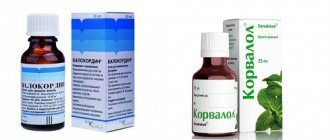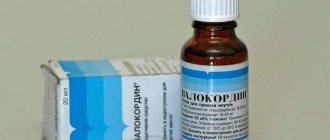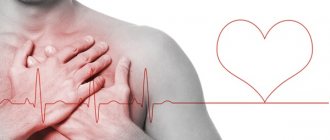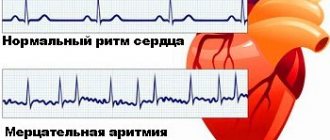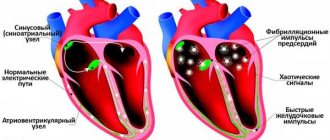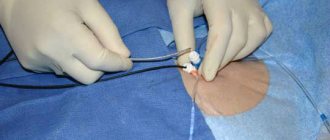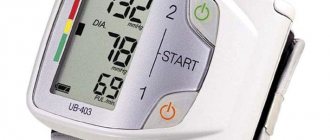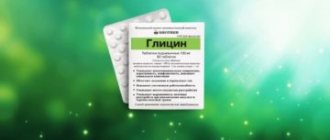The drug "Corvalol" is actively used for cardiac arrhythmia, due to its ability to have a positive complex effect on the cardiovascular system. The medication successfully relieves vascular spasms, reduces central nervous system excitation, normalizes blood pressure and prevents many cardiovascular pathologies. However, it is worth understanding that Corvalol does not treat arrhythmia; it can only cope with the symptoms accompanying the disease, but at the same time, it will improve the functioning of the entire body.
Efficacy and impact of the drug
When chest pain occurs, a very fast heartbeat is felt - these are signs of arrhythmia. In this case, most experts recommend taking Corvalol, which produces effective results after the first dose.
Corvalol consists of plant and synthetic components. It includes:
- Alpha-bromoisovaleric acid ester and ethanol 96%. Reduces excitability and helps eliminate arrhythmia in stressful situations. The components have a sedative and antispasmodic effect, therefore under their influence a person becomes less excitable.
- Peppermint oil . It has a calming effect and has a beneficial effect on the manifestation of arrhythmia symptoms. It contains menthol and its esters. The component has a strong effect, due to which the blood vessels dilate and the stomach and intestines contract. Peppermint has a rich minty flavor. It is an excellent antiseptic and antispasmodic.
- Phenobarbital. Helps calm the heart, calming effect, improves sleep.
You can buy Corvalol at the pharmacy in tablets or in an alcohol solution.
Composition, release form and action
Corvalol is available in the form of tablets and drops. The composition of the drug depends on the form of release. This relationship can be seen in the table:
- ethyl ester of alpha-bromisiovaleric acid - 12.42 mg;
- phenobarbital - 11.34 mg;
- mint oil - 0.88 mg.
- alpha-bromisiovaleric acid ethyl ester - 2%;
- phenobarbital - 1.82%;
- peppermint oil - 0.14%;
- sodium hydroxide;
- ethyl alcohol 90%;
- distilled water.
Corvalol relieves vascular spasms and reduces excitation of the central nervous system. Reduces stimulation of the cerebral cortex, so it can be used as a sleeping pill (it helps to sleep well). Quickly reduces blood pressure and prevents diseases of the cardiovascular system. In addition to the effect on the heart, thanks to the presence of mint oil, it has an effect on the gastrointestinal tract (bloating is eliminated) and the biliary system (bile is excreted more actively). Thus, Corvalol improves the functioning of the entire body.
How to use?
There are several types of arrhythmia. Let's look at how to take the drug and in what doses:
- Tachycardia. If the heart rate increases to 90 beats per minute, Corvalol should be taken 30 minutes before meals. Dosage: 1-2 tablets or 30-40 drops. The daily dose should not exceed 6 tablets or 60 drops. Read more about taking Corvalol for tachycardia here.
- Bradycardia (slow heart rate). For this disorder, take the drug 2 tablets or 40-50 drops (in case of a severe attack that cannot be stopped).
- Atrial fibrillation (chaotic contraction of the atria). Simple dosage: 2-3 tablets or 30-45 drops of Corvalol 2-3 times a day.
- Extrasystole.
Dosage
Dosage of the drug (see table).
| Form | Dose for systematic use (2–3 times a day) | Maximum dose for tachycardia and myocardial vasospasm | Note |
| Drops | 15–30 drops | 50 drops | In 30–50 ml of water |
| Pills | By 1 | 3 tables | Under the tongue or inside |
| Capsules | 1–2 each | 3 capsules | Inside |
Contraindications
Corvalol is not as harmless as it might seem at first glance. There are many contraindications to taking Corvalol. So, who should not take the drug:
- people with individual intolerance or allergic reactions to the components;
- those who have problems with the kidneys and liver;
- patients who have suffered a traumatic brain injury;
- pregnant women and breastfeeding mothers;
- children under 18 years of age;
- people suffering from lactase deficiency, alcoholism or epilepsy.
Before taking Corvalol, it is very important to first familiarize yourself with the contraindications, so as not to encounter serious consequences in the future.
Side effects
The drug also has some side effects that may occur when taken during treatment for arrhythmia. How do side effects occur:
- discomfort occurs in the abdomen, breathing is impaired;
- dizziness and nausea appear (in rare cases, hallucinations);
- sleep is disturbed, heart rate decreases, blood pressure drops;
- Constipation may occur.
It is not recommended to take the drug for a long time, as there is a risk of addiction to phenobarbital. Not only will the drug's effectiveness be insignificant, but the patient may also experience symptoms such as anxiety or agitation.
Watch an excerpt from a TV show about health, which talks about what will happen if you take too much Corvalol:
Compatibility
Before starting treatment of arrhythmia with the drug in question, it is necessary to study the possibility of its interaction with other drugs. Thus, phenobarbital can have a stimulating effect on liver enzymes, so it is not recommended to use it simultaneously with medications that are metabolized in the liver. In addition, Corvalol enhances the pharmacological effect of valproic acid, increases the toxic effect of Methotrexate and enhances the therapeutic activity of hypnotics, analgesics and local anesthetic pharmaceuticals. It is strictly contraindicated to combine ari therapy with the consumption of alcoholic beverages, due to the ability of ethyl to increase the toxicity and effect of the sedative drug on the central nervous system.
Recommendations
Corvalol can be used in conjunction with various antiarrhythmic and antihypertensive drugs. This is very convenient for many patients, as well as older people, since they often suffer from diabetes or other serious diseases.
But Corvalol cannot be taken with all medications; for example, it is better not to combine it with sleeping pills, hormonal contraceptives or steroid hormones.
The drug is incompatible with alcoholic beverages, since Corvalol includes ethanol. This component significantly enhances the negative effects of phenobarbital and the toxicity of the drug itself. Therefore, to calm down, it is better to choose one of two things - Corvalol or alcohol.
Efficacy and impact of the drug
When chest pain occurs, a very fast heartbeat is felt - these are signs of arrhythmia. In this case, most experts recommend taking Corvalol, which produces effective results after the first dose.
Corvalol consists of plant and synthetic components. It includes:
- Alpha-bromoisovaleric acid ester and ethanol 96%. Reduces excitability and helps eliminate arrhythmia in stressful situations. The components have a sedative and antispasmodic effect, therefore under their influence a person becomes less excitable.
- Peppermint oil . It has a calming effect and has a beneficial effect on the manifestation of arrhythmia symptoms. It contains menthol and its esters. The component has a strong effect, due to which the blood vessels dilate and the stomach and intestines contract. Peppermint has a rich minty flavor. It is an excellent antiseptic and antispasmodic.
- Phenobarbital. Helps calm the heart, calming effect, improves sleep.
You can buy Corvalol at the pharmacy in tablets or in an alcohol solution.
Composition and properties
The components of Corvalol are the following components with characteristic therapeutic effects for each:
- Phenobarbital. Acts as a tranquilizer, and also helps to calm down after severe stress and normalizes sleep, relieving insomnia. The therapeutic effect of this substance is aimed at reducing the excitability of neurons in the cerebral cortex.
- Ethyl ether. It has sedative properties and helps reduce the excitability of the central nervous system.
- Peppermint oil. The unique component of the drug acts as an irritant to the receptors of the oral cavity, dilating the blood vessels of the brain and heart muscle. This component also has a choleretic and antiseptic effect.
The components included in Corvalol interact well with each other, giving the drug other medicinal properties, namely, the ability to reduce high blood pressure and prevent headaches and heart spasms.
How to use?
There are several types of arrhythmia. Let's look at how to take the drug and in what doses:
- Tachycardia. If the heart rate increases to 90 beats per minute, Corvalol should be taken 30 minutes before meals. Dosage: 1-2 tablets or 30-40 drops. The daily dose should not exceed 6 tablets or 60 drops. Read more about taking Corvalol for tachycardia here.
- Bradycardia (slow heart rate). For this disorder, take the drug 2 tablets or 40-50 drops (in case of a severe attack that cannot be stopped).
- Atrial fibrillation (chaotic contraction of the atria). Simple dosage: 2-3 tablets or 30-45 drops of Corvalol 2-3 times a day.
- Extrasystole.
Indications and dosage of Corvalol for arrhythmia
There are different types of arrhythmia. This is tachycardia, when the heart contracts at a speed of more than 100 per minute, and bradycardia, in which the heart rhythm reaches 60 beats or less per minute.
Sinus arrhythmia is a condition in which the rate of contraction during inhalation is greater than during exhalation. Extrasystole - when contractions do not occur in sequence, but single tremors are felt in the chest area.
Atrial fibrillation is a condition in which the heart rhythm is seriously disrupted, and the atria and their contractions are distorted in one of their phases. For arrhythmias, Corvalol is used.
The medication does not directly affect the rhythm. But at the same time it is used for a pain syndrome called cardialgia. In this case, unpleasant sensations are concentrated in the heart area. Also indicated are sinus tachycardia, when all phases of the heart rhythm remain unchanged.
Cardiac arrhythmias
Tachycardia can be caused by various factors. These are also changes in the heart of an organic nature, which do not allow the electrical impulse to pass correctly through the conductive systems. These conditions include:
Inflammation. The same applies to disturbances in electrolyte metabolism in the blood plasma, which can be caused by a lack of magnesium and potassium.
- Hormonal changes such as PMS.
- The entry of a large amount of adrenaline into the blood.
- Anemia, when hemoglobin levels drop under the influence of nicotine and caffeine.
- Exercise stress.
- Malfunction of the autonomic nervous system.
- Hyperfunction of the thyroid gland.
Thyroid diseases
When an attack of tachycardia occurs, you feel:
- weakness;
- lack of air;
- panic.
Lack of air
All this together can further increase your heart rate. In this situation, Corvalol comes to the rescue despite the fact that it does not directly affect the root cause of such manifestations.
Rather, the medication calms the patient, promotes vasodilation, while the heart does not suffer.
When exacerbation episodes occur particularly frequently, it is necessary to examine the patient to understand the root cause. Help in this regard will be provided by an electrocardiogram, laboratory tests and blood pressure measurement. It is especially important to conduct laboratory tests on blood plasma electrolytes.
Corvalol helps if the blood vessels inside the myocardium have undergone minor spasms, and the pressure has also increased, but only slightly. The same goes for:
- sinus tachycardia;
- neurosis;
- spasm of the biliary tract and intestines.
People who have problems falling asleep often resort to medication. In addition to tablet forms, capsules are also produced today. They are taken orally, while tablets can be dissolved by placing them under the tongue. The dosage for systematic use is 1/2 capsule. As for tachycardia and spasms of heart vessels, a maximum of 3 capsules can be taken at a time.
The drug in capsules
Contraindications
Corvalol is not as harmless as it might seem at first glance. There are many contraindications to taking Corvalol. So, who should not take the drug:
- people with individual intolerance or allergic reactions to the components;
- those who have problems with the kidneys and liver;
- patients who have suffered a traumatic brain injury;
- pregnant women and breastfeeding mothers;
- children under 18 years of age;
- people suffering from lactase deficiency, alcoholism or epilepsy.
Before taking Corvalol, it is very important to first familiarize yourself with the contraindications, so as not to encounter serious consequences in the future.
Side effects
The drug also has some side effects that may occur when taken during treatment for arrhythmia. How do side effects occur:
- discomfort occurs in the abdomen, breathing is impaired;
- dizziness and nausea appear (in rare cases, hallucinations);
- sleep is disturbed, heart rate decreases, blood pressure drops;
- Constipation may occur.
It is not recommended to take the drug for a long time, as there is a risk of addiction to phenobarbital. Not only will the drug's effectiveness be insignificant, but the patient may also experience symptoms such as anxiety or agitation.
Watch an excerpt from a TV show about health, which talks about what will happen if you take too much Corvalol:
Overdose
Drowsiness in a person may be a sign of exceeding the dose of the drug.
The following symptoms indicate an overdose of Corvalol:
- a sharp drop in blood pressure;
- decreased body temperature;
- bradycardia;
- confusion;
- labored breathing;
- reduction in the volume of urine excreted;
- inhibition of the central nervous system;
- dizziness;
- drowsiness;
- collapse;
- coma.
Treatment of overdose is symptomatic. Long-term use of the drug "Corvalol" can cause dependence, withdrawal symptoms and psychomotor agitation. It is not recommended to abruptly stop the therapeutic course, otherwise withdrawal syndrome may be provoked. In order for Ari therapy to give exclusively positive effects, you must strictly adhere to all the recommendations of your doctor and not self-medicate.
Efficacy and impact of the drug
When chest pain occurs, a very fast heartbeat is felt - these are signs of arrhythmia. In this case, most experts recommend taking Corvalol, which produces effective results after the first dose.
Corvalol consists of plant and synthetic components. It includes:
- Alpha-bromoisovaleric acid ester and ethanol 96%. Reduces excitability and helps eliminate arrhythmia in stressful situations. The components have a sedative and antispasmodic effect, therefore under their influence a person becomes less excitable.
- Peppermint oil . It has a calming effect and has a beneficial effect on the manifestation of arrhythmia symptoms. It contains menthol and its esters. The component has a strong effect, due to which the blood vessels dilate and the stomach and intestines contract. Peppermint has a rich minty flavor. It is an excellent antiseptic and antispasmodic.
- Phenobarbital. Helps calm the heart, calming effect, improves sleep.
You can buy Corvalol at the pharmacy in tablets or in an alcohol solution.
How to use?
There are several types of arrhythmia. Let's look at how to take the drug and in what doses:
- Tachycardia. If the heart rate increases to 90 beats per minute, Corvalol should be taken 30 minutes before meals. Dosage: 1-2 tablets or 30-40 drops. The daily dose should not exceed 6 tablets or 60 drops. Read more about taking Corvalol for tachycardia here.
- Bradycardia (slow heart rate). For this disorder, take the drug 2 tablets or 40-50 drops (in case of a severe attack that cannot be stopped).
- Atrial fibrillation (chaotic contraction of the atria). Simple dosage: 2-3 tablets or 30-45 drops of Corvalol 2-3 times a day.
- Extrasystole.
Emergency medicine
#image.jpg - premature contraction of the entire heart or just the ventricles from an impulse emanating from a site outside the normal pacemaker of the heart - the sinus node. Depending on the location of the source of such an impulse, supraventricular (supraventricular) emanating from the atria or atrioventricular node, and ventricular extrasystoles are distinguished.
Clinical picture. The presence of extrasystoles can be determined by examining the pulse and auscultation of the heart. Almost any extrasystole is accompanied by prolongation of cardiac diastole (compensatory pause). With atrial extrasystoles, it is little pronounced; with ventricular extrasystoles, a long compensatory pause is observed, defined by the patients themselves as freezing or a feeling of cardiac arrest followed by a strong impulse. A long pause may be accompanied by dizziness, weakness, and visual disturbances (“flickering spots”, “darkening in the eyes”). Extrasystoles without a compensatory pause (or with a pause of short duration), more often supraventricular and especially frequent extrasystoles are felt by patients as palpitations or “interruptions”. According to ECG data, it is possible to determine the location of the extrasystole both in the atria and in the ventricles. The most distinct signs of ventricular extrasystole are the absence of the P wave, deformation of the ventricular complex (QRS) and the presence of a compensatory pause (Fig. 26). With supraventricular extrasystole, the QRS complex is not deformed, the pause is little expressed or absent, the P wave is positive, less often negative (Fig. 27) Emergency care. In most cases, extrasystole does not require emergency treatment and you can limit yourself to explaining the nature of the disease (psychoprophylaxis), as well as prescribing remedies from the patient’s arsenal and advice to consult a local doctor. This applies, first of all, to extrasystole in cardioneurosis and myocardiopathy. In cases where extrasystole occurs against the background of pain (or immediately after its end), after long-term use of digitalis drugs (digitalis, digoxin, etc. glycoside intoxication), as well as with a decrease in blood pressure, treatment with the introduction of antiarrhythmic drugs is necessary. When diagnosing acute coronary insufficiency, complex therapy is carried out aimed at relieving pain, stabilizing hemodynamics and myocardial metabolism, and eliminating disorders of the blood coagulation system. Particular attention should be paid to patients with frequent ventricular extrasystoles, especially those following shortly or immediately after the T wave (early extrasystoles and type R on T), which are often precursors to ventricular fibrillation.
For medical emergency treatment of extrasystolin, the following measures are indicated:
1. Sedatives orally, and if necessary, get a quick effect - parenterally: Seduxen (5 mg tablets, 10 mg intravenously), Valocordin or Corvalol (50 drops).
2. Antiarrhythmic drugs . For supraventricular arrhythmia, when there is no need for a rapid manifestation of the effect, tablet drugs can be prescribed: a) blockers of 0-adrenergic receptors; anaprilin (obzidan, inderal) in a dose of 20-40 mg, oxprenolol (trazicor) - 20 mg (contraindications: bronchial asthma, hypotension, bradycardia, conduction disturbances); b) verapamil (isoptin)—40 mg; ajmaline (gilurythmal) - 50 mg; d) novocainamide - 0.5 g; g) potassium preparations (panangin, potassium orotate). It is more effective to administer these drugs intravenously in a bolus when diluted in 10-20 ml of 0.9% sodium chloride: obzidan 5-10 mg, isoptin 5-10 mg, gilurythmal 50 mg; novocainamide 0.5 g (5 ml of 10% solution), panangin 10 ml. (Intravenous drugs should be administered slowly under blood pressure and ECG monitoring.)
3. Emergency care for ventricular extrasystole against
a) lidocaine according to the scheme: 4 ml of 2% solution (80 mg) intravenously in a stream for 3-4 minutes in 10 ml of 0.9% sodium chloride solution, then intravenously 200-400 mg in 400 ml of polyglucin (reopoliglucin) at a rate of 15 -20 drops per minute, additionally at the 10th minute of intravenous infusion of 40 mg (2 ml of 2% solution) in 10 ml of 0.9% sodium chloride solution for 3-4 minutes. It is possible to replace the drip infusion with intramuscular injection of 400 mg of lidocaine every 3 hours. In case of deficiency of the drug, an initial dose of 80 mg is slowly administered intravenously, and then 40 mg every 10-20 minutes. Contraindication: II-III degree atrioventricular block;
b) novocainamide 5-10 ml (0.5-1.0 g) 10% solution intravenously in 20 ml of 0.9% sodium chloride solution. It is administered over 10 minutes under the control of ECG, pulse rate, blood pressure, and the patient’s well-being. When the heart rate decreases to less than 60 per minute, the systolic blood pressure decreases by more than 30 mmHg. Art. from the initial level, if dizziness or weakness occurs, the drug is stopped. If hypotension (collapse) develops, the head end of the bed should be lowered, a slow intravenous stream of 0.2-0.3 ml of a 1% mesatone solution in 10 ml of a 0.9% sodium chloride solution should be administered intravenously and 0.7-0.8 ml intramuscularly. For bradycardia less than 60 per minute, 0.5-1.0 ml of a 0.1% atropine solution is administered intravenously. If blood pressure has not stabilized within 10 minutes, proceed to intravenous administration of polyglucin. Patients with complications after the administration of novocainamide are necessarily transferred to specialized teams. Contraindications: initial hypotension, severe heart failure, atrioventricular block, bundle branch block, individual intolerance, bradycardia;
c) anaprilin (obzidan, inderal) 5-10 mg intravenously. Inject slowly at a rate of 1 mg/min in 10 ml of 0.9% sodium chloride solution. Administration is preferable for concomitant hypertension and tachycardia. Contraindications: heart failure, hypotension, atrioventricular block, bronchial asthma. Possible complications: hypotension associated with a sharp slowdown in heartbeat;
d) slow intravenous injection of panangin - 10 ml, drip injection of a polarizing mixture (100 ml of 5% glucose solution, 20 ml of panangin, 5 units of insulin). Potassium preparations are mandatory administered to patients with extra asystole as a result of glycoside intoxication.
When choosing a treatment plan, you must choose one of the available options. availability of drugs. The combination of these drugs can lead to rapid onset of side effects and complications. Antiarrhythmic therapy is carried out as part of the treatment of the underlying disease (see “Myocardial infarction”).
Emergency medical care, ed. B. D. Komarova, 1985
Contraindications
Corvalol is not as harmless as it might seem at first glance. There are many contraindications to taking Corvalol. So, who should not take the drug:
- people with individual intolerance or allergic reactions to the components;
- those who have problems with the kidneys and liver;
- patients who have suffered a traumatic brain injury;
- pregnant women and breastfeeding mothers;
- children under 18 years of age;
- people suffering from lactase deficiency, alcoholism or epilepsy.
Before taking Corvalol, it is very important to first familiarize yourself with the contraindications, so as not to encounter serious consequences in the future.
Side effects
The drug also has some side effects that may occur when taken during treatment for arrhythmia. How do side effects occur:
- discomfort occurs in the abdomen, breathing is impaired;
- dizziness and nausea appear (in rare cases, hallucinations);
- sleep is disturbed, heart rate decreases, blood pressure drops;
- Constipation may occur.
It is not recommended to take the drug for a long time, as there is a risk of addiction to phenobarbital. Not only will the drug's effectiveness be insignificant, but the patient may also experience symptoms such as anxiety or agitation.
Watch an excerpt from a TV show about health, which talks about what will happen if you take too much Corvalol:
Recommendations
Corvalol can be used in conjunction with various antiarrhythmic and antihypertensive drugs. This is very convenient for many patients, as well as older people, since they often suffer from diabetes or other serious diseases.
But Corvalol cannot be taken with all medications; for example, it is better not to combine it with sleeping pills, hormonal contraceptives or steroid hormones.
The drug is incompatible with alcoholic beverages, since Corvalol includes ethanol. This component significantly enhances the negative effects of phenobarbital and the toxicity of the drug itself. Therefore, to calm down, it is better to choose one of two things - Corvalol or alcohol.
In conclusion, we can say that Corvalol actually helps reduce blood pressure. But before taking it, you need to make sure that the patient has no contraindications and that the medication is safe for him to avoid serious consequences.
Drug interactions
Sleeping pills, sedatives, some antiepileptic drugs, ethanol potentiate the effect of Corvalol.
When taken in parallel with gold preparations, the risk of nephrotic syndrome increases, and with non-steroidal anti-inflammatory drugs - gastric ulcers.
Phenobarbital contains:
- accelerates the inclusion in the metabolism of a number of medications processed by liver enzymes (including anticoagulants, glycosides, antibiotics, hypoglycemic drugs, hormonal contraceptives, antiarrhythmic and blood pressure-lowering drugs);
- potentiates the effect of analgesics;
- prolongs its effect in combination with monoamine oxidase inhibitors;
- increases the toxicity of zidovudine and metatrexate.
